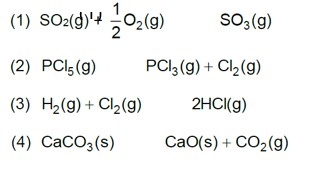7.71. What is the maximum concentration of equimolar solutions of ferrous sulphate and sodium sulphide so that when mixed in equal volumes, there is no precipitation of iron sulphide?
(For iron sulphide, Ksp=6.3 x 10−18)
7.71. What is the maximum concentration of equimolar solutions of ferrous sulphate and sodium sulphide so that when mixed in equal volumes, there is no precipitation of iron sulphide?
(For iron sulphide, Ksp=6.3 x 10−18)
-
1 Answer
-
Let the maximum concentration of each solution be x mol/L. After mixing, the volume of the concentrations of each solution will be reduced to half i.e., x/2.
∴ [FeSO4]= [Na2S]=x / 2
Then, [Fe2+]= [FeSO4]=x/ 2
Also, [S2−]= [Na2S]=x/2
FeS (x)↔Fe2+ (aq)+S2− (aq)
Ksp= [Fe2+] [S2−]
= >6.3×10−18= (x/2) (x/2)
x2/4=6.3×10−18
⇒x= 5.02×10−9
If the concentrations of both solutions are equal to or less than 5.02×10−9M, then there will be no precipitation of iron sulphide.
Similar Questions for you
0.01 M NaOH,
M = 1 * 10-2

pOH = 2
pH = 2
Kp = Kc (RT)Dng
36 * 10–2 = Kc (0.0821 * 300)–1
Kc = 0.36 * 0.0821 * 300 = 8.86 » 9
A(g) ->B(g) + (g)
Initial moles n 0 0
Eqb. moles n(1 – a) na
total moles =
Eqb. pressure
On increasing pressure, equilibrium moves in that direction where number of gaseous moles decreases.
Taking an Exam? Selecting a College?
Get authentic answers from experts, students and alumni that you won't find anywhere else
Sign Up on ShikshaOn Shiksha, get access to
- 65k Colleges
- 1.2k Exams
- 679k Reviews
- 1800k Answers


